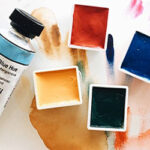How To Blend Acrylic Paint
Acrylic paint is notorious for its fast drying time. This can be especially difficult for artists who are familiar with watercolor or oil paint to work around, particularly when it comes to blending.
In this article we will explore different tips and techniques commonly used for blending in acrylics.
Written by: Mot Tuman

Typically, blending is done while the paint is still wet, this can be difficult when working with an acrylic paint because it dries much faster than other mediums.
An artist can lay down a color, go to mix another to blend it with, and by the time they come back their paint has already dried. This can lead to streaky, sharp lines that ruin the blended effect.
There are many different ways to remedy this problem, here are some common techniques you could use:
Pre-mix Your Paint
One of the easiest solutions for blending is to mix your colors prior to painting. This is for specifically when you know you want to create a smooth transition between two colors.
Mixing each color beforehand allows you to focus on blending when the paint is still wet and not worrying about creating your next color, allowing for a smoother experience.
Slow-drying Mediums
If pre-determining your colors is not possible for you, then mixing mediums into your paint to slow down the drying time can be extremely helpful. The best acrylic medium for this is known as a retarding medium. This medium will make sure the paint is “open” for longer, meaning it will prevent your paint from filming over and drying rapidly.
That being said, while retarding medium is made specifically for slowing the drying time of paints, too much of it can break apart acrylic because it does not contain a binder. Only a few drops is needed for a dollop of paint.
With retarding medium it is also important to remember not to layer paint without retarding medium on top of paint with retarding medium. This is because the paint layered on top will dry faster and could potentially trap moisture in your painting.
Always make sure your layer of open paint dries before applying the next layer.

Other Mediums For Blending
Other mediums, such as gloss or matte medium, while not specifically for lengthening open time, will help extend your paints surface coverage and dry time to some extent, while still maintaining the paints integrity as they contain an acrylic binder.
If you need help blending in a smooth gradient but your first paint color has already dried, then you could try harnessing transparency using a glazing medium. By slowly working from less glazing medium to more glazing medium you can create a gradient from your second color to a transparent layer overlapping the color you originally wanted to blend with.
While this can make a painting unnecessarily complicated if done too often, it will work if it is not ideal for you to repaint the first color.
Mix The In-Between
If you have laid down two colors and decided that you want to have a gradient between them, one thing you can do is mix the transition color. When doing this it’s important to keep in mind that a 50/50 mixture of each color is not always going to give you the perfect transition.
Colors with darker values or more opaque colors will over power lighter and more transparent colors. For instance, when trying to find the mid-value between blue and yellow, you might need to mix in more yellow than blue in order to create a realistic transition. The more transition colors you add, the smoother your gradient will appear.

Use Tools
Using other tools and methods to apply your paint may also help in the blending process. Applying your acrylic in thicker consistencies on the canvas, such as with palette knives, can give you a longer time to work since the paint takes longer to dry in larger amounts. Using a slightly damp sponge to blot the paint on may also help you to rapidly create gradients.
Special palettes, such as stay wet palettes, can also help to keep your paints wet for longer. They are air-tight palettes that contain a sponge and palette paper. When palette paper is layered on top of the sponge, any paint on it will stay open for longer. This can help you stop from having to re-mix colors for blending as often.
Frequently Asked Questions (Q&A)
What does it mean when a paint is “open”?
A: When a paint is open it means it has not started to develop a film and dry. Specialty open acrylic paints are made to stay wet longer than traditional fast drying acrylics.
Can you blend acrylic paint once it’s dried?
A: Once acrylic begins to become tacky it can not be blended anymore. Using a glazing medium to create a gradient from transparent to opaque paint over top of dried areas can help achieve a blended effect.
How can you make acrylic blend smoothly?
A: Including a small amount of gloss or matte medium can help smooth out the texture of acrylics. Opting for a fluid acrylic might also help.
More Resources





